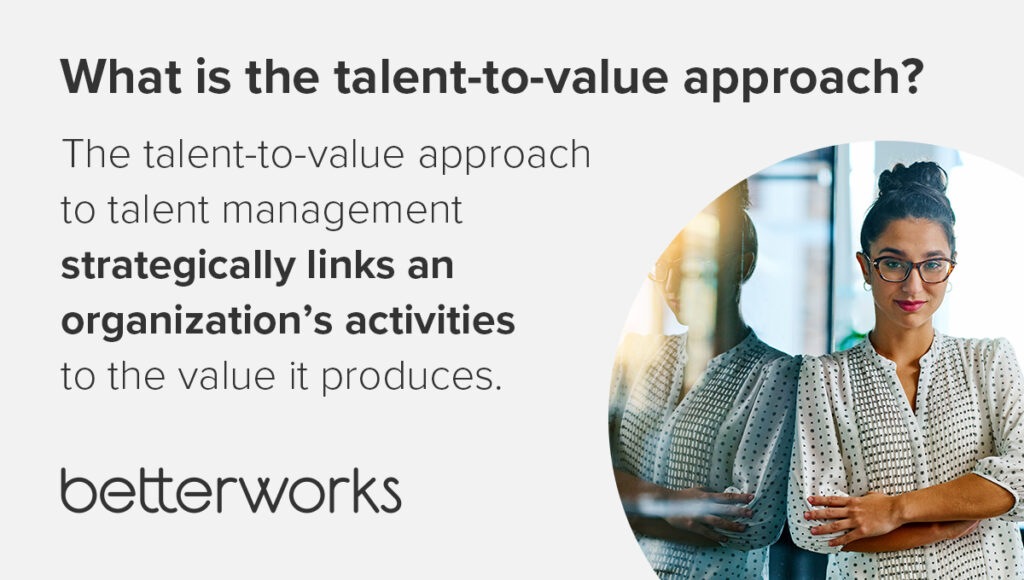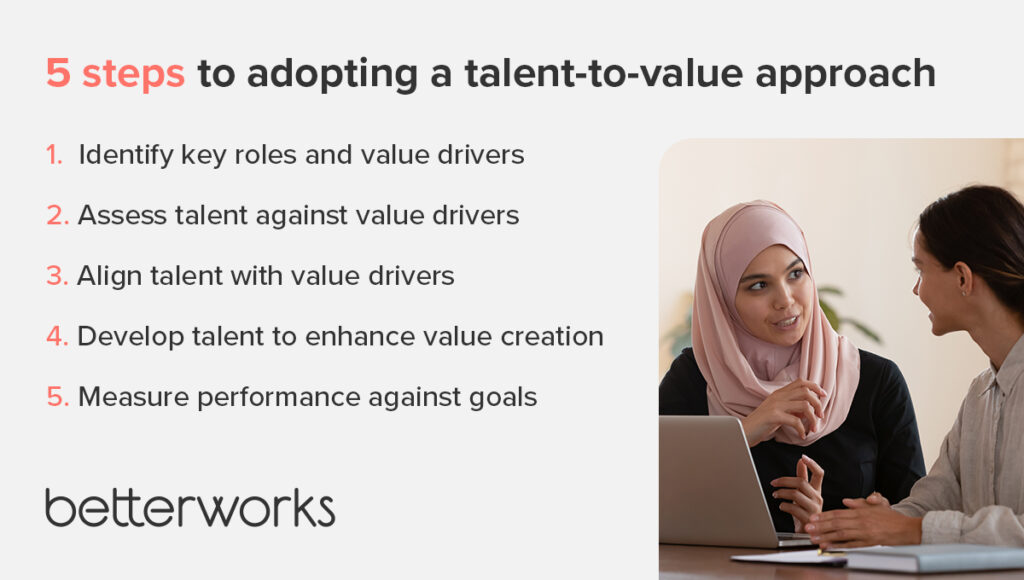Placing the right people in your company’s most important roles doesn’t happen by chance. To make strategic talent placement decisions, you need to know which roles create the most value for your business. You might be surprised at what roles drive value — and that’s where a talent-to-value approach comes into play.
A talent-to-value approach acknowledges that talent is a powerful resource when properly aligned with business goals. It goes beyond standard talent management practices by concentrating on the direct link between talent and value. By connecting talent to value, you can maximize your human advantage, improve organizational performance, and gain a sustainable competitive edge by driving value creation across the business.
Learn more about the talent-to-value approach, how to adopt it in your organization, and why matching talent to value helps enterprises succeed.
The value of talent management
Talent management is essential for forming a productive team, inspiring creativity, and maintaining competitive advantage. By effectively managing talent, you put the right people in the right roles and ensure your workforce has the skills and abilities needed to drive success.
Talent management can improve outcomes for individuals, the business, and the culture. Good talent management includes career advancement, recognition, and rewards, all of which help your high-potential team members feel happy and engaged. As a result, companies spend less on hiring and training and retain a deeper inventory of employee knowledge and skills.
A different approach to matching talent to key roles
Rather than simply filling positions based on resume qualifications, the talent-to-value approach is a more strategic and dynamic way of allocating talent to create enterprise value. Here are the major distinctions between these two approaches.
Standard talent allocation
Standard talent allocation emphasizes hierarchy more than influence. This approach assumes that the roles that create the most value sit at the top of the organizational chart. Consequently, that leads to HR reserving leadership development opportunities for high-potential talent moving up the ladder. However, relying on fixed structures misses the nuance of influence and value creation.
For example, while customer service representatives don’t have a high-ranking title, their ability to create positive customer experiences and loyalty can measurably influence organizational success and profit.
The talent-to-value approach
The talent-to-value strategy for talent management links an organization’s activities to its ability to create value. This approach focuses on recognizing and cultivating people’s talents, capabilities, and potential so that they can maximize their value contribution — regardless of where they sit on the org chart.
The talent-to-value approach involves identifying the top drivers of organizational value and developing them accordingly. This includes looking at each role in terms of value creation, making sure you have the right people in those roles, and ensuring that these employees have the tools and resources they need to maximize their potential.

5 steps to adopting the talent-to-value approach
Adopting a talent-to-value approach to talent management involves shifting the focus from managing talent to understanding how talent contributes to organizational value creation. When you learn how to match talent to value, you can drive long-term business growth.
Identify key roles and value drivers
Start by understanding the key activities and capabilities that drive value creation in your organization. This requires analyzing the business strategy, goals, and competitive landscape. Engage with senior leaders and key stakeholders to identify the critical value drivers that align with your organization’s objectives.
Advanced analytics can help you pinpoint the biggest value drivers in the business. A technique like organizational network analysis, for instance, highlights the people with the greatest positive influence on their colleagues. Your performance data can reveal a lot about which roles and people drive the most value, too. Betterworks’ interactive Analytics and Insights dashboard, for example, helps users uncover the top drivers of performance in the organization.
Assess talent against value drivers
After identifying essential value drivers, evaluate your workforce to establish their talents, capabilities, and opportunities. Look at performance assessments, capabilities reviews, and talent reviews to better understand your workforce’s individual strengths and areas needing improvement. This evaluation will help you assess your workforce’s current state against the identified value drivers.
Align talent with value drivers
Set clear goals for increasing value creation in the business. There are different types of values, and each person brings unique strengths to the conversation. An effective manager, for example, might generate increased financial value (such as revenue growth and profitability), while a customer representative might increase customer satisfaction and loyalty. Identify the types of value you need to drive, then align your workforce to bring your goals to life.
Organize your talent in a fashion that corresponds with their key success contributions. This might require reassigning or retaining people for positions that capitalize on their strengths and abilities. In other circumstances, the best step is to form cross-functional teams to accomplish value-building activities. Whatever you do, you need the right people in the right roles to get the most out of their abilities and actions.
Develop talent to enhance value creation
Develop customized growth plans to improve employee abilities. Offer coaching, mentorship, and other training activities that align with the major value contributors. Foster a culture of ongoing education and leadership development to ensure that team members can deliver maximum results.
Measure performance against goals
Track and measure your talent’s performance against goals. Set metrics and feedback mechanisms to track progress and identify areas for improvement. Evaluate your talent’s impact on value creation against the expected outcomes. This analysis will help you determine whether you’ve placed people in the right roles to achieve your value-creation targets.

How to leverage dynamic talent allocation for enterprise value
Dynamic talent allocation is a way to place the right talent in the right roles based on changing business needs. This way of thinking recognizes that the skills and capabilities your organization needs can change over time. Because of that, you must be flexible in reallocating human capital to meet these changes and sustain organizational success.
Implement dynamic human capital allocation strategies
Create a company culture that welcomes change and encourages employees to be flexible, resilient, and open to new possibilities. Adopting such a mindset helps employees be more responsive to changes in their duties and see growth opportunities.
Establish systems that make internal mobility possible, such as job rotations, internal job postings, and talent marketplaces. These initiatives allow employees to explore different job roles, departments, and relationships within the company. They gain new knowledge and broader experience and can contribute to a wider range of business activities.
Unlock enterprise value through talent transformation
A talent-to-value approach allows you to respond quickly to changing business needs and optimize talent allocation for maximum impact.
Use an iterative process to make sure that talent management plans stay in line with changing business demands. This change management process involves regularly judging the results of talent initiatives, getting employee and manager feedback, and adjusting as necessary to maximize value production.
Matching talent to value through performance management
Performance management that occurs continuously in the flow of work has tremendous potential to enable a talent-to-value approach to talent allocation by helping managers and employees link performance to high-level value-creation goals. The result is improved talent management, where employees understand how their work contributes to organizational goals.
The data generated by these ongoing conversations can show leaders what’s working and what’s not so they can quickly adapt. HR leaders can use data collected in real-time to make informed decisions about how to assign talent to achieve maximum efficiency. By using this data-driven approach, you’ll allocate talent in the most effective way to increase the odds of organizational success.
Want to learn more? Discover how to master talent mapping to drive strategic growth.
Help employees grow into roles where they can best help your business grow.






